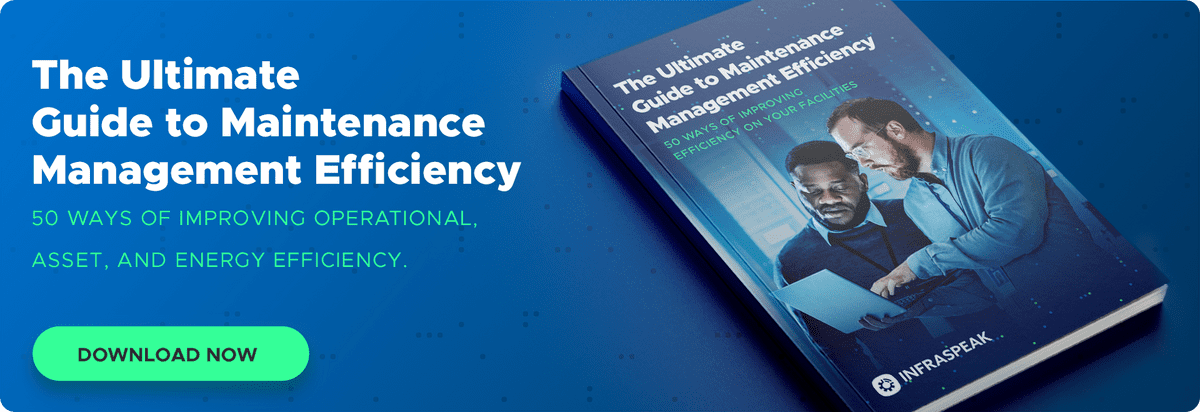Total Productive Maintenance (TPM) is an asset management strategy, especially common in lean manufacturing. It’s based on the idea that all members of the workforce should engage in day to day maintenance, rather than falling exclusively on the technicians’ shoulders.
TPM aims at zero breakdowns with no unplanned downtime, zero defective products, and no work accidents. Sounds like an impossible mission? Not if you turn every team member into a 007 – secret maintenance agent.
Who’s responsible for Total Productive Maintenance?
Let’s begin with a simple exercise. Imagine that you live in a building with multiple floors, lifts, lights and fire extinguishers on each floor, electric gates, and an array of equipment. We bet that you’d do anything to keep them in perfect condition. Not the least because you know they’re also your responsibility, a complement to the house you’ve bought or rented.
If one day you notice that the electric driveway gate is not responding to the remote, what do you do? Since it’s something you use every day, you’re quick to report it. But what if the property manager doesn’t pick up the phone? Or if there’s no technician available? Maybe you’ll take the reins and contact the installation company directly.
Now, time to go back to work. Is it efficient to unload all maintenance duties onto one person (or the technicians)? Shouldn’t everyone who uses equipment daily (shop-floor workers) be accountable? You see what we’re getting at. After all, company assets are like the facilities you share with neighbours: everyone needs them to work as smoothly as possible.
A Total Productive Maintenance strategy proposes every employee participates in industrial maintenance – albeit in different ways, according to their job.
Industrial engineers and managers
Engineers and managers should be the first to promote TPM within the company. Engineers have a greater responsibility because they should also monitor and interpret data collected through the maintenance management software.
Maintenance managers and technicians
Maintenance managers and technicians should train workers to perform regular screenings and preventive maintenance activities, so as to comply with their goals.
Shop Floor Workers
Shop floor workers are usually the people who use the equipment day after day, and they should feel accountable for them. They may take care of cleaning, machine lubrication, and other routine maintenance tasks. Plus they’ll likely be the first ones to notice a potential failure, and should report it immediately on the maintenance management platform.
Advantages of Total Productive Maintenance
We know what you’re asking. Aren’t we complicating things with this “total productive maintenance” plan? Aren’t we asking too much of these workers? Of course that TPM has a few downsides – like training every worker to be a “preventive maintenance agent” – but the advantages are undeniable.
When the entire team is focused on keeping assets available and reliable for as long as possible, the company performs much better.
Fewer breakdowns
When workers are alert to potential failures, it’s more likely that they’ll notice malfunctions early on. Repairs will enter into the preventive maintenance pipeline immediately, and your team will never have to deal with emergencies or unplanned downtime.
Decreases unplanned maintenance
If you find yourself performing more and more unplanned maintenance, then your team is not detecting failures soon enough. When the whole team shares that responsibility – including those who use equipment daily – it’s a big step towards overcoming that challenge. Over time, unplanned maintenance will decrease.
Better overall performance
The ultimate goal of TPM is better performance. Since no failure or malfunction goes unnoticed, (1) reactive maintenance decreases, and (2) you avoid a giant backlog of work orders. Besides, maintenance technicians have more time to dedicate themselves to truly complex and top-priority tasks.
Improved work safety
In some machines, preventive maintenance works like collective insurance: a malfunction may risk the well-being of everyone who works in the building. Also, remember that rushing and working under pressure doesn’t help. The more urgent the intervention is, the more risks your technicians are likely to take during repairs.
Decreased production costs
TPM increases OEE and decreases downtime. This means that production capacity improves, which leads to more potential profit. On the other hand, you save on corrective maintenance, which is almost always more expensive than preventive action. All and all, the better your TPM strategy, the closer you should be to an OEE of 100%.
What are the 8 Pillars of TPM?
For such an ambitious strategy to work, there needs to be a few strong pillars. This brings us to the 8 Pillars of Total Productive Maintenance, which are the fundamental principles of TPM:
- Focused Improvement
- Autonomous Maintenance
- Quality Maintenance
- Planned Maintenance
- Early Equipment Maintenance
- Training and Education
- Safety, Health & Environment
- Office TPM
Read more about these pillars in our article about the 8 Pillars of Total Productive Maintenance.
While you’re here, how about checking out our ultimate guide to maintenance management efficiency?
We’ve compiled 50 actionable tips over more than 20 pages of in-depth content on how to drive operational, asset and energy efficiency. Downoad it for free and make your operation more efficient today.
Total Productive Maintenance and Industry 4.0
We know that we are in a turning point in industrial maintenance. There are still a lot of unfulfilled promises regarding Industry 4.0 due to the high investment costs they require. Yet, it is important to understand how new maintenance strategies complement Industry 4.0 and vice-versa.
Autonomous maintenance
Like we suggested above, maybe you’re afraid of overloading regular workers with maintenance tasks. That might be true with today’s equipment, but it will change as machines become more autonomous.
It already happens with cars, which are now capable of warning you when to change the oil, for example, or with industrial equipment connected to a dashboard. It’s the machine itself that “warns” us it needs maintenance, making it easier for everybody.
Predictive maintenance
One of the greatest promises of Industry 4.0 is creating integrated systems, namely through sensors connected to a cloud. This technology can also be applied to predictive maintenance. People operating these systems will then be responsible for maintenance, following TPM principles.
Long-distance support and training
The idea that every worker is accountable for proper maintenance is the basis of a TPM strategy. This means they should also know how to proceed in case of failure. With Industry 4.0, it will become increasingly easier to train workers online or offer them remote support 24/7 – whilst managers can keep up using an IMMP.
Safety at Work
Safety is something all maintenance managers are sensitive to. We’ve already explained how TPM promotes work safety, but you can go even further with air quality and temperature sensors for extra comfort.
Maintenance will be a broader concept
If every worker is connected to their teammates – from administrative personnel to shop floor workers – every worker needs to be accountable for their own machines. It’s impossible to manage all of these assets without direct intervention from those who operate them daily. TPM will be a must-have for Industry 4.0
Do you want to know more about intelligent industrial maintenance? Check out our article on the power of IIoT (Industrial Internet of Things).


